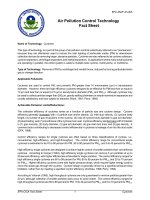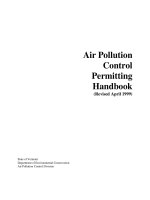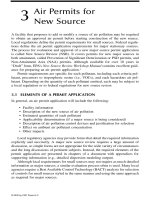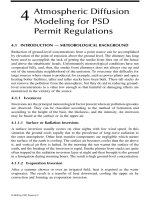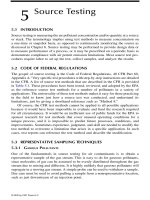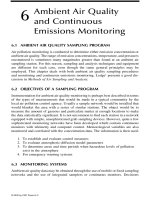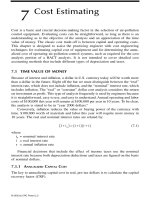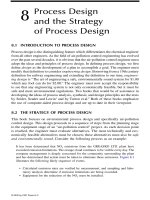AIR POLLUTION CONTROL TECHNOLOGY HANDBOOK - CHAPTER 1 potx
Bạn đang xem bản rút gọn của tài liệu. Xem và tải ngay bản đầy đủ của tài liệu tại đây (1.13 MB, 32 trang )
AIR POLLUTION
CONTROL
TECHNOLOGY
HANDBOOK
The Mechanical Engineering Handbook Series
Series Editor
Frank Kreith
Consulting Engineer
Published Titles
Handbook of Heating, Ventilation, and Air Conditioning
Jan F. Kreider
Computational Intelligence in Manufacturing Handbook
Jun Wang and Andrew Kusiak
The CRC Handbook of Mechanical Engineering
Frank Kreith
The CRC Handbook of Thermal Engineering
Frank Kreith
The Handbook of Fluid Dynamics
Richard W. Johnson
Hazardous and Radioactive Waste Treatment Technologies Handbook
Chang Ho Oh
The MEMS Handbook
Mohamed Gad-el-Hak
Air Pollution Control Technology Handbook
Karl B. Schnelle, Jr. and Charles A. Brown
Forthcoming Titles
Biomedical Technology and Devices Handbook
James Moore and George Zouridakis
Fuel Cell Technology Handbook
Gregor Hoogers
Handbook of Mechanical Engineering, Second Edition
Frank Kreith and Massimo Capobianchi
Handbook of Non-Destructive Testing and Evaluation Engineering
James Tulenko and David Hintenlang
Inverse Engineering Handbook
Keith A. Woodbury
Opto-Mechatronic Systems Handbook: Techniques and Applications
Hyung Suck Cho, Toshio Fukuda, and George Barbastathis
© 2002 by CRC Press LLC
CRC PRESS
Boca Raton London New York Washington, D.C.
Authored by
Karl B. Schnelle, Jr., Ph.D., P.E.
Vanderbilt University
Nashville, Tennessee
Charles A. Brown, P.E.
VECO Pacific, Inc.
Bellingham, Washington
AIR POLLUTION
CONTROL
TECHNOLOGY
HANDBOOK
This book contains information obtained from authentic and highly regarded sources. Reprinted material
is quoted with permission, and sources are indicated. A wide variety of references are listed. Reasonable
efforts have been made to publish reliable data and information, but the author and the publisher cannot
assume responsibility for the validity of all materials or for the consequences of their use.
Neither this book nor any part may be reproduced or transmitted in any form or by any means, electronic
or mechanical, including photocopying, microfilming, and recording, or by any information storage or
retrieval system, without prior permission in writing from the publisher.
The consent of CRC Press LLC does not extend to copying for general distribution, for promotion, for
creating new works, or for resale. Specific permission must be obtained in writing from CRC Press LLC
for such copying.
Direct all inquiries to CRC Press LLC, 2000 N.W. Corporate Blvd., Boca Raton, Florida 33431.
Trademark Notice:
Product or corporate names may be trademarks or registered trademarks, and are
used only for identification and explanation, without intent to infringe.
Visit the CRC Press Web site at www.crcpress.com
© 2002 by CRC Press LLC
No claim to original U.S. Government works
International Standard Book Number 0-8493-9588-7
Library of Congress Card Number 2001037498
Printed in the United States of America 1 2 3 4 5 6 7 8 9 0
Printed on acid-free paper
Library of Congress Cataloging-in-Publication Data
Schnelle, Karl B.
Air pollution control technology handbook / Karl B. Schnelle, Jr. and Charles A. Brown.
p. cm. (Mechanical engineering handbook series)
Includes bibliographical references and index.
ISBN 0-8493-9588-7 (alk. paper)
1. Air Pollution Handbooks, manuals, etc. 2. Air Purification Equipment and
supplies Handbooks, manuals, etc. I. Brown, Charles A. (Charles Arnold), 1951- II.
Title. III. Series.
TD883 .S283 2001
628.5
′
3 dc21 2001037498
9588 fm frame Page 4 Wednesday, September 5, 2001 9:38 PM
Dedication
The authors would like to dedicate this book to all the students who have been in
their air pollution control courses at Vanderbilt University, Western Washington
University, Gonzaga University, and Education Services of the American Institute
of Chemical Engineers. We appreciate your attendance, your attentiveness, and your
desire to improve our environment.
9588 fm frame Page 5 Wednesday, September 5, 2001 9:38 PM
© 2002 by CRC Press LLC
Preface
DESIGN YIELDS NEW ACTION MOST IDEAL
TO ENVIRONMENT
This book is written to serve as a reference handbook for the practicing engineer or
scientist who needs to prepare the basic process engineering and cost estimation
required for the design of an air pollution control system. The user of this book
should have a fundamental understanding of the factors resulting in air pollution
and a general knowledge of the techniques used for air pollution control. The topics
presented in this handbook are covered in sufficient depth so that the user can proceed
with the basic equipment design using the methods and design equations presented.
Although moving sources, especially those powered by internal combustion engines,
are serious contributors to the air pollution problem, this book will focus on station-
ary sources. Furthermore, this handbook will not consider nuclear power plants or
other radioactive emissions. Therefore, the major audience for this book will be
engineers and scientists in the chemical and petroleum processing industry and steam
power plant and gas turbine industry.
Using this book the air pollution control systems designer may
• Begin to select techniques for control
• Review alternative design methods
• Review equipment proposals from vendors
• Initiate cost studies of control equipment
This book is certainly suitable for anyone with an engineering or science back-
ground who needs to get a basic introduction to air pollution control equipment
design. It could also be used as a text or reference book in a continuing education
program or a university classroom.
9588 fm frame Page 6 Wednesday, September 5, 2001 9:38 PM
© 2002 by CRC Press LLC
Acknowledgments
Professor Schnelle wishes to acknowledge the assistance of his former student
Dr. Partha Dey and his wife Anita Dey as well as his current student Atip Laung-
phairojana for the preparation of 70 drawings which are part of the chapters he
wrote. There would have been no book without their help. Furthermore, Professor
Schnelle is forever grateful to his wife Mary Dabney Schnelle who read every word
he wrote including the equations. She helped remove many errors of grammar and
spelling and corrected errors of algebra and definition that the author did not find.
Mr. Brown would like to acknowledge the assistance of Dr. Michael Durham,
Dr. Jean Bustard, and Ms. Lynn McGuire for their review and suggestions for content
of selected chapters. Also, he truly appreciates the software application support
provided by his wife Susan Brown, and is eternally thankful for her loving encour-
agement, patience, and support while writing this book and during all of his profes-
sional endeavors.
9588 fm frame Page 7 Wednesday, September 5, 2001 9:38 PM
© 2002 by CRC Press LLC
Authors
Karl B. Schnelle, Jr., Ph.D., P.E.,
is Professor of Chemical and Environmental
Engineering, has been a member of the Vanderbilt University Faculty for more than
40 years. He has served as Chair of the Environmental and Water Resources Engi-
neering Program and the Chemical Engineering Department for a total of 14 years.
He has extensive publications in the chemical engineering and environmental area.
Dr. Schnelle is an emeritus member of both the American Institute of Chemical
Engineers and the Air and Waste Management Association. He is a Fellow of the
American Institute of Chemical Engineers and a Diplomate of the American Acad-
emy of Environmental Engineers. He has been a lecturer in the American Institute
of Chemical Engineers continuing education program for more than 30 years, where
he has taught the Designing Air Pollution Control Systems and the Atmospheric
Dispersion Modeling courses.
Dr. Schnelle is a licensed Professional Engineer in the State of Tennessee. He
has been an environmental consultant to the World Health Organization, the Envi-
ronmental Protection Agency, the U.S. State Department, and the state of Tennessee
and Nashville Air Pollution Control Agencies as well as to numerous private cor-
porations. He has served two terms as a member of the Air Pollution Control Board
of the state of Tennessee and continues teaching full time at Vanderbilt University.
Charles A. Brown, P.E.,
is a Principal Staff Process Engineer with VECO Pacific,
Inc., in Bellingham, WA, where he is responsible for air pollution control process
design and air permitting projects for various clients. Also, he is an instructor for
the short course on Designing Air Pollution Control Equipment for the American
Institute of Chemical Engineers and an instructor for the course in Air Quality at
Western Washington University’s Huxley College. He is a member of the American
Institute of Chemical Engineers, where he served as Director of the Environmental
Division, and of the Air and Waste Management Association.
Mr. Brown is a licensed Professional Engineer in Washington, California, and
North Dakota. He has more than 26 years of experience in a variety of industries,
and has authored several articles and papers related to chemical engineering and air
pollution controls.
9588 fm frame Page 8 Wednesday, September 5, 2001 9:38 PM
© 2002 by CRC Press LLC
Contents
Chapter 1
A Historical Overview of the Development of Clean Air
Regulations
1.1 A Brief History of the Air Pollution Problem
1.2 Federal Involvement in Air Pollution Control
1.3 Characterizing the Atmosphere
1.4 Recipe for an Air Pollution Problem
1.4.1 Sources of Air Pollution
1.4.2 Meteorological Parameters Affecting Transport of Pollutants
1.4.3 The Effects of Air Pollution — A Comparison of London Fog
and Los Angeles Smog
Refereances
Chapter 2
Clean Air Act
2.1 History of the Clean Air Act
2.1.1 1970 Clean Air Act Amendments
2.1.1.1 National Ambient Air Quality Standards
2.1.1.2 New Source Performance Standards
2.1.1.3 Hazardous Air Pollutants
2.1.1.4 Citizen Suits
2.1.2 1977 Clean Air Act Amendments
2.1.2.1 Prevention of Significant Deterioration
2.1.2.2 Offsets in Non-Attainment Areas
2.2 1990 Clean Air Act Amendments
2.2.1 Title I: Provisions for Attainment and Maintenance of National
Ambient Air Quality Standards
2.2.1.1 NAAQS Revisions
2.2.2 Title II: Mobile Sources
2.2.3 Title III: Hazardous Air Pollutant Program
2.2.3.1 Source Categories
2.2.3.2 Establishing MACT Standards
2.2.3.3 Risk Management Plans
2.2.4 Title IV: Acid Deposition Control
2.2.5 Title V: Operating Permits
2.2.6 Title VI: Stratospheric Ozone Protection
2.2.7 Title VII: Enforcement
2.2.8 Title VIII: Miscellaneous Provisions
2.2.9 Title IX: Research
9588 fm frame Page 9 Wednesday, September 5, 2001 9:38 PM
© 2002 by CRC Press LLC
2.2.10 Title X: Disadvantaged Business
2.2.11 Title XI: Employment Transition Assistance
References
Chapter 3
Air Permits for New Source
3.1 Elements of a Permit Application
3.1.1 Applicability
3.1.1.1 Potential to Emit
3.1.1.2 Fugitive Emissions
3.1.1.3 Secondary Emissions
3.1.2 Significant Emission Rates
3.1.3 Modification
3.1.4 Emissions Netting
3.1.4.1 Netting Example
3.2 Best Available Control Technology
3.2.1 Step 1: Identify Control Technologies
3.2.2 Step 2: Eliminate Technically Infeasible Options
3.2.3 Step 3: Rank Remaining Options by Control Effectiveness
3.2.4 Step 4: Evaluate Control Technologies in Order of Control
Effectiveness
3.2.4.1 Energy Impacts
3.2.4.2 Environmental Impacts
3.2.4.3 Economic Impacts and Cost Effectiveness
3.2.5 Step 5: Select BACT
3.3 Air Quality Analysis
3.3.1 Preliminary Analysis
3.3.2 Full Analysis
3.4 NSR Reform
References
Chapter 4
Atmospheric Diffusion Modeling for PSD Permit Regulations
4.1 Introduction — Meteorological Background
4.1.1 Inversions
4.1.1.1 Surface or Radiation Inversions
4.1.1.2 Evaporation Inversion
4.1.1.3 Advection Inversion
4.1.1.4 Subsidence Inversion
4.1.2 The Diurnal Cycle
4.1.3 Principal Smoke-Plume Models
4.2 The Tall Stack
4.3 Classifying Sources by Method of Emission
4.3.1 A Definition of Tall Stacks
4.3.2 Process Stacks
9588 fm frame Page 10 Wednesday, September 5, 2001 9:38 PM
© 2002 by CRC Press LLC
4.4 Atmospheric-Diffusion Models
4.4.1 Other Uses of Atmospheric-Diffusion Models
4.5 EPA Computer Programs for Regulation of Industry
4.5.1 The Industrial Source Complex Model
4.5.2 Screening Models
4.5.3 The New Models
4.6 The Source–Transport–Receptor Problem
4.6.1 The Source
4.6.2 Transport
4.6.2.1 The Effective Emission Height
4.6.2.2 Bulk Transport of the Pollutants
4.6.2.3 Dispersion of the Pollutants
4.6.3 The Receptor
References
Chapter 5
Source Testing
5.1 Introduction
5.2 Code of Federal Regulations
5.3 Representative Sampling Techniques
5.3.1 Gaseous Pollutants
5.3.2 Velocity and Particulate Traverses
5.3.3 Isokinetic Sampling
References
Chapter 6
Ambient Air Quality and Continuous Emissions Monitoring
6.1 Ambient Air Quality Sampling Program
6.2 Objectives of a Sampling Program
6.3 Monitoring Systems
6.3.1 Fixed vs. Mobile Sampling
6.3.2 Continuous vs. Integrated Sampling
6.3.3 Selection of Instrumentation and Methods
6.4 Federal Reference Methods and Continuous Monitoring
6.5 The “Complete” Environmental Surveillance and Control System
6.6 Typical Air Sampling Train
6.7 Integrated Sampling Devices for Suspended Particulate Matter
6.8 Continuous Air Quality Monitors
6.8.1 Electroconductivity Analyzer for SO
2
6.8.2 Coulometric Analyzer for SO
2
6.8.3 Nondispersive Infrared Method for CO
6.8.4 Flame Photometric Detection of Total Sulfur and SO
2
6.8.5 Hydrocarbons by Flame Ionization
6.8.6 Fluorescent SO
2
Monitor
9588 fm frame Page 11 Wednesday, September 5, 2001 9:38 PM
© 2002 by CRC Press LLC
6.8.7 Chemilumenescence for Detection of Ozone and Nitrogen
Oxides
6.8.8 Calibration of Continuous Monitors
6.8.8.1 Specifications for Continuous Air-Quality Monitors
6.8.8.2 Steady-State Calibrations
References
Chapter 7
Cost Estimating
7.1 Time Value of Money
7.1.1 Annualized Capital Cost
7.1.2 Escalation Factors
7.2 Types of Cost Estimates
7.3 Air Pollution Control Equipment Cost
7.3.1 OAQPS Control Cost Manual
7.3.2 Other Cost-Estimating Resources
References
Chapter 8
Process Design and the Strategy of Process Design
8.1 Introduction to Process Design
8.2 The Strategy of Process Design
8.2.1 Process Flowsheets
8.3 Mass and Energy Balances
8.3.1 A Mass-Balance Example
8.3.2 An Energy-Balance Example
References
Chapter 9
Profitability and Engineering Economics
9.1 Introduction — Profit Goal
9.2 Profitability Analysis
9.2.1 Mathematical Methods for Profitability Evaluation
9.2.2 Incremental Rate of Return on Investments as a Measure of
Profitability
9.2.2.1 An Example
9.3 The Effect of Depreciation
9.3.1 An Example
9.4 Capital Investment and Total Product Cost
9.4.1 Design Development
References
9588 fm frame Page 12 Wednesday, September 5, 2001 9:38 PM
© 2002 by CRC Press LLC
Chapter 10
Introduction to Control of Gaseous Pollutants
10.1 Absorption and Adsorption
10.1.1 Fluid Mechanics Terminology
10.1.2 Removal of HAP and VOC by Absorption and Adsorption
Reference
Chapter 11
Absorption for HAP and VOC Control
11.1 Introduction
11.2 Aqueous Systems
11.3 Nonaqueous Systems
11.4 Types and Arrangements of Absorption Equipment
11.5 Design Techniques for Countercurrent Absorption Columns
11.5.1 Equilibrium Relationships
11.5.2 Ideal Solutions — Henry’s Law
11.5.3 Countercurrent Absorption Tower Design Equations
11.5.4 Origin of Volume-Based Mass-Transfer Coefficients
11.5.4.1 Steady-State Molecular Diffusion
11.5.5 The Whitman Two-Film Theory
11.5.6 Overall Mass-Transfer Coefficients
11.5.7 Volume-Based Mass-Transfer Coefficients
11.5.8 Determining Height of Packing in the Tower: the HTU
Method
11.5.9 Dilute Solution Case
11.6 Countercurrent Flow Packed Absorption Tower Design
11.6.1 General Considerations
11.6.2 Operations of Packed Towers
11.6.3 Choosing a Tower Packing
11.6.3.1 Dumped Packings
11.6.4 Packed Tower Internals
11.6.5 Choosing a Liquid–Gas Flow Ratio
11.6.6 Determining Tower Diameter — Random Dumped Packing
11.6.7 Determining Tower Diameter — Structured Packing
11.6.8 Controlling Film Concept
11.6.9 A Correlation for the Effect of L/G Ratio on the Packing
Height
11.6.10 Henry’s Law Constants and Mass-Transfer Information
11.6.11 Using Henry’s Law for Multicomponent Solutions
11.7 Sample Design Calculation
11.7.1 Flooding
11.7.2 Structured Packing
References
9588 fm frame Page 13 Wednesday, September 5, 2001 9:38 PM
© 2002 by CRC Press LLC
Chapter 12
Adsorption for HAP and VOC Control
12.1 Introduction to Adsorption Operations
12.2 Adsorption Phenomenon
12.3 Adsorption Processes
12.3.1 Stagewise Process
12.3.2 Continuous Contact, Steady-State, Moving-Bed Adsorbers
12.3.3 Unsteady-State, Fixed-Bed Adsorbers
12.3.4 Newer Technologies
12.3.4.1 Rotary Wheel Adsorber
12.3.4.2 Chromatographic Adsorption
12.3.4.3 Pressure Swing Adsorption
12.4 Nature of Adsorbents
12.4.1 Adsorption Design with Activated Carbon
12.4.1.1 Pore Structure
12.4.1.2 Effect of Relative Humidity
12.5 The Theories of Adsorption
12.6 The Data of Adsorption
12.7 Adsorption Isotherms
12.7.1 Freundlich’s Equation
12.7.2 Langmuir’s Equation
12.7.3 The Brunner, Emmett, Teller, or BET, Isotherm
12.7.3.1 Adsorption without Capillary Condensation
12.7.3.2 Adsorption with Capillary Condensation
12.8 Polanyi Potential Theory
12.9 Unsteady-State, Fixed-Bed Adsorbers
12.10 Fixed-Bed Adsorber Design Considerations
12.10.1 Safety Considerations
12.11 Pressure Drop Through Adsorbers
12.12 Adsorber Effectiveness and Regeneration
12.12.1 Steam Regeneration
12.12.2 Hot Air or Gas Regeneration
12.13 Breakthrough Model
12.13.1 Mass Transfer
12.13.2 Breakthrough Curve Example
12.14 Regeneration Modeling
References
Chapter 13
Thermal Oxidation for VOC Control
13.1 Combustion Basics
13.2 Flares
13.2.1 Elevated, Open Flare
13.2.2 Smokeless Flare Assist
13.2.3 Flare Height
9588 fm frame Page 14 Wednesday, September 5, 2001 9:38 PM
© 2002 by CRC Press LLC
13.2.4 Ground Flare
13.2.5 Safety Features
13.3 Incineration
13.3.1 Recuperative Thermal Oxidizer
13.3.2 Regenerative Thermal Oxidizer
13.3.3 Recuperative vs. Regenerative Design Selection
13.4 Catalytic Oxidation
References
Chapter 14
Control of VOC and HAP by Condensation
14.1 Introduction
14.2 VOC Condensers
14.2.1 Contact Condensers
14.2.2 Surface Condensers
14.2.2.1 An Example — Condensation Temperature
14.3 Coolant and Heat Exchanger Type
14.3.1 An Example — Heat Exchanger Area and Coolant Flow Rate
14.4 Mixtures of Organic Vapors
14.4.1 An Example — Condensation of a Binary Mixture
14.5 Air As a Noncondensable
References
Appendix A: Derivation of the Area Model for a Mixture Condensing
from a Gas
Appendix B: Algorithm for the Area Model for a Mixture Condensing
from a Gas
Chapter 15
Control of VOC and HAP by Biofiltration
15.1 Introduction
15.2 Theory of Biofilter Operation
15.3 Design Parameters and Conditions
15.3.1 Depth and Media of Biofilter Bed
15.3.2 Microorganisms
15.3.3 Oxygen Supply
15.3.4 Inorganic Nutrient Supply
15.3.5 Moisture Content
15.3.6 Temperature
15.3.7 pH of the Biofilter
15.3.8 Loading and Removal Rates
15.3.9 Pressure Drop
15.3.10 Pretreatment of Gas Streams
15.4 Biofilter Compared to Other Available Control Technology
15.5 Successful Case Studies
15.6 Further Considerations
References
9588 fm frame Page 15 Wednesday, September 5, 2001 9:38 PM
© 2002 by CRC Press LLC
Chapter 16
Membrane Separation
16.1 Overview
16.2 Polymeric Membranes
16.3 Performance
16.4 Applications
References
Chapter 17
NO
x
Control
17.1 NO
x
from Combustion
17.1.1 Thermal NO
x
17.1.2 Prompt NO
x
17.1.3 Fuel NO
x
17.2 Control Techniques
17.2.1 Combustion Control Techniques
17.2.1.1 Low-Excess Air Firing
17.2.1.2 Overfire Air
17.2.1.3 Flue Gas Recirculation
17.2.1.4 Reduce Air Preheat
17.2.1.5 Reduce Firing Rate
17.2.1.6 Water/Steam Injection
17.2.1.7 Burners out of Service (BOOS)
17.2.1.8 Reburn
17.2.1.9 Low-NO
x
Burners
17.2.1.10 Ultra Low-NO
x
Burners
17.2.2 Flue Gas Treatment Techniques
17.2.2.1 Selective Noncatalytic Reduction (SNCR)
17.2.2.2 Selective Catalytic Reduction (SCR)
17.2.2.3 Low-Temperature Oxidation with Absorption
17.2.2.4 Catalytic Absorption
17.2.2.5 Corona-Induced Plasma
References
Chapter 18
Control Of SO
x
18.1 H
2
S Control
18.2 SO
2
(and HCl) Removal
18.2.1 Reagents
18.2.1.1 Calcium-Based Reactions
18.2.1.2 Calcium-Based Reaction Products
18.2.1.3 Sodium-Based Reactions
18.2.1.4 Sodium-Based Reaction Products
18.2.2 Capital vs. Operating Costs
18.2.2.1 Operating Costs
9588 fm frame Page 16 Wednesday, September 5, 2001 9:38 PM
© 2002 by CRC Press LLC
18.2.3 SO
2
Removal Processes
18.2.3.1 Wet Limestone
18.2.3.2 Wet Soda Ash or Caustic Soda
18.2.3.3 Lime Spray Drying
18.2.3.4 Circulating Lime Reactor
18.2.3.5 Sodium Bicarbonate/Sodium Sesquicarbonate
Injection
18.2.3.6 Other SO
2
Removal Processes
18.2.4 Example Evaluation
18.3 SO
3
and Sulfuric Acid
18.3.1 SO
3
and H
2
SO
4
Formation
18.3.2 Toxic Release Inventory
References
Chapter 19
Fundamentals of Particulate Control
19.1 Particle-Size Distribution
19.2 Aerodynamic Diameter
19.3 Cunningham Slip Correction
19.4 Collection Mechanisms
19.4.1 Basic Mechanisms: Impaction, Interception, Diffusion
19.4.1.1 Impaction
19.4.1.2 Interception
19.4.1.3 Diffusion
19.4.2 Other Mechanisms
19.4.2.1 Electrostatic Attraction
19.4.2.2 Gravity
19.4.2.3 Centrifugal Force
19.4.2.4 Thermophoresis
19.4.2.5 Diffusiophoresis
References
Chapter 20
Hood and Ductwork Design
20.1 Introduction
20.2 Hood Design
20.2.1 Flow Relationship for the Various Types of Hoods
20.2.1.1 Enclosing Hoods
20.2.1.2 Rectangular or Round Hoods
20.2.1.3 Slot Hoods
20.2.1.4 Canopy Hoods
20.3 Duct Design
20.3.1 Selection of Minimum Duct Velocity
20.3.2 The Mechanical Energy Balance
9588 fm frame Page 17 Wednesday, September 5, 2001 9:38 PM
© 2002 by CRC Press LLC
20.3.2.1 Velocity Head
20.3.2.2 Friction Head
20.4 Effect of Entrance into a Hood
20.5 Total Energy Loss
20.6 Fan Power
20.7 Hood-Duct Example
References
Chapter 21
Cyclone Design
21.1 Collection Efficiency
21.1.1 Factors Affecting Collection Efficiency
21.1.2 Theoretical Collection Efficiency
21.1.3 Lapple’s Efficiency Correlation
21.1.4 Leith and Licht Efficiency Model
21.1.5 Comparison of Efficiency Model Results
21.2 Pressure Drop
21.3 Saltation
References
Chapter 22
Design and Application of Wet Scrubbers
22.1 Introduction
22.2 Collection Mechanisms and Efficiency
22.3 Collection Mechanisms and Particle Size
22.4 Selection and Design of Scrubbers
22.5 Devices for Wet Scrubbing
22.6 The Semrau Principle and Collection Efficiency
22.7 A Model for Counter-Current Spray Scrubbers
22.7.1 Application to a Spray Tower
22.8 A Model for Venturi Scrubbers
22.9 The Calvert Cut Diameter Design Technique
22.9.1 An Example Calculation
22.9.2 Second Example Problem
22.10 The Cut-Power Relationship
References
Additional References
Appendix A: Calvert Performance Cut Diameter Data
Chapter 23
Filtration and Baghouses
23.1 Introduction
23.2 Design Issues
9588 fm frame Page 18 Wednesday, September 5, 2001 9:38 PM
© 2002 by CRC Press LLC
23.3 Cleaning Mechanisms
23.3.1 Shake/Deflate
23.3.2 Reverse Air
23.3.3 Pulse Jet (High Pressure)
23.3.4 Pulse Jet (Low Pressure)
23.3.5 Sonic Horns
23.4 Fabric Properties
23.4.1 Woven Bags
23.4.2 Felted Fabric
23.4.3 Surface Treatment
23.4.4 Weight
23.4.5 Membrane Fabrics
23.4.6 Catalytic Membranes
23.4.7 Pleated Cartridges
23.4.8 Ceramic Candles
23.5 Baghouse Size
23.5.1 Air-to-Cloth Ratio
23.5.2 Can Velocity
23.6 Pressure Drop
23.7 Bag Life
23.7.1 Failure Modes
23.7.2 Inlet Design
23.7.3 Startup Seasoning
References
Chapter 24
Electrostatic Precipitators
24.1 Early Development
24.2 Basic Theory
24.2.1 Corona Formation
24.2.2 Particle Charging
24.2.3 Particle Migration
24.2.4 Deutsch Equation
24.2.4.1 Sneakage
24.2.4.2 Rapping Re-Entrainment
24.2.4.3 Particulate Resistivity
24.2.4.4 Gas-Flow Distribution
24.3 Practical Application of Theory
24.3.1 Effective Migration Velocity
24.3.2 Automatic Voltage Controller
24.4 Flue Gas Conditioning
24.4.1 Humidification
24.4.2 SO
3
24.4.3 Ammonia
24.4.4 SO
3
and Ammonia
9588 fm frame Page 19 Wednesday, September 5, 2001 9:38 PM
© 2002 by CRC Press LLC
24.4.5 Ammonium Sul fate
24.4.6 Proprietary Addit ives
24.5 Using V-I Curves for Troubleshootin g
Reference s
9588 fm frame Page 20 Wednesday, September 5, 2001 9:38 PM
© 2002 by CRC Press LLC
A Historical Overview
of the Development of
Clean Air Regulations
1.1 A BRIEF HISTORY OF THE AIR POLLUTION PROBLEM
Media reports about air pollution might lead us to think of air pollution as being
something that developed in the second half of the 20th century. But this is not so.
The kind of air pollution to which human beings have been exposed has changed
with time, but air pollution has been known in larger cities at least from the
14th century when people first started using coal for heating their homes.
1
In England, during the reign of Edward I, there was a recorded protest by the
nobility about the use of “sea” coal which burned in an unusually smoky manner.
Under his successor, Edward II (1307–1327), a man was put to torture for filling
the air with a “pestilential odor” through the use of coal. Under the reigns of
Richard III and Henry V, England undertook to restrict the use of coal through
taxation. Nevertheless, the situation continued to grow worse in the larger cities, so
much so that during the reign of Elizabeth I (1533–1603, Queen, 1550–1603)
Parliament passed a law forbidding the use of coal in the city of London while
Parliament was in session. While this may have eased the pollution for the parlia-
mentarians, it did very little to actually solve the problem.
As cities grew and the Industrial Revolution developed, the spread of coal smoke
grew. In 1686, a paper was presented to the Royal Philosophical Society on “An
Engine That Consumes Smoke.” To this day we have been working on this same
problem, as yet to no avail. Legislation that was introduced often ignored the
technical aspects of the problem, and hence was unenforceable. For example, a law
passed by Parliament in 1845 stated that locomotives must consume their own smoke,
which would be grand but, of course, it is not realizable.
The air pollution problem in the U.S. was first recognized as being due to coal
smoke. In 1881 Chicago adopted a smoke control ordinance. St. Louis, Cincinnati,
and other cities also adopted smoke ordinances in the years that followed. In these
early years, it was established that the responsibility rested with the state and local
governments.
Nashville, Tennessee had a population of 80,865 in 1900, and it was a typical
community of that period that depended on bituminous coal for heating. A short
story written by O’Henry describes his visit to Nashville in 1900 as follows:
1
9588ch01 frame Page 1 Wednesday, September 5, 2001 9:39 PM
© 2002 by CRC Press LLC
A M
UNICIPAL
R
EPORT
Nashville — a city, port of delivery, and the capital of the state of Tennessee, is on the
Cumberland River and on the N.C. & St. L. and the L&N Railroads. This city is
regarded as the most important educational centre in the South. I stepped off the train
at 8 P.M. Having searched thesaurus in vain for adjectives, I must, as a substitution,
hie me to comparison in the form of a recipe:
“ Take of London fog, thirty parts; malaria, ten parts; gas leaks, twenty parts; dewdrops
gathered in a brick-yard at sunrise, twenty-five parts; odor of honeysuckle, fifteen parts.
Mix. The mixture will give you a approximate conception of a Nashville drizzle. It is
not so fragrant as a moth ball, nor as thick as pea soup; but ’tis enough — ’twill serve.”
From 1930 to 1941, the focus of air pollution was on smoke control laws. Public
protest groups from Chicago, St. Louis, Cincinnati, and Pittsburgh had some success.
However, air pollution was not recognized as the health hazard we know it to be
today.
In 1941 war was declared on the Axis Powers of Germany and Japan and their
allies, and from late 1941 until 1945, there was an all-out effort to defeat these
countries. This effort allowed no time nor materials for air pollution control. Smoke
levels reached new highs as the national effort rallied to the war. Finally with a
return to peace, action on pollution control was initiated.
In the prewar era, Pittsburgh had enacted a stringent new control regulation. In
October 1946, a regulation which centered on the type of coal used was put into
effect. Then, in October of 1948, tragedy struck at Donora, Pennsylvania.
2
Weather
conditions were perfect for a stagnating inversion. As the inversion deepened, people
in Donora became ill, and 20 died from the effects of the excessive air pollution
which was prevalent. The result was an awakening to the health hazards of air
pollution. Other such incidents were recognized throughout the world as indicated
in Table 1.1 compiled from several sources.
2-4
Thus, October 1948 marks the start of a more vigorous program of air pollution
control in the U.S. For example, on May 1, 1949 the Pittsburgh smoke ordinance
was extended to the whole of Allegheny County. Air pollution abatement was soon
to attract the public’s eye and money, but it wasn’t until the advent of the Clean Air
Act of 1963 that there was a national awakening to the value of our air environment.
During World War II a new type of air pollution had been discovered in the
Los Angeles atmosphere. New effects were manifest in the form of eye and skin
irritation and plant damage not evident from simple smoke pollution. It was the
result of a photochemical smog that was at first attributed to the oil refineries and
storage facilities. When controls of these facilities did not result in a significant
reduction of the problem, it was then discovered that the internal combustion engine
was a major cause of this new type of pollution. The result of photochemical
oxidation is seen in the brown haze apparent in the upper layer of the atmosphere.
The brown haze is a mixture of particulates, oxides of nitrogen, sulfuric-acid mist
condensed from the oxidation of sulfur dioxide, and particles produced from pho-
tochemical reaction in the atmosphere. The haze limits visibility, decreases the
9588ch01 frame Page 2 Wednesday, September 5, 2001 9:39 PM
© 2002 by CRC Press LLC
amount of sunlight reaching the earth, results in an increase in the amount of cloudy
weather present, and, when it accumulates, results in all the unpleasant effects we
associate with air pollution.
Perhaps it was in response to these visual signs of air pollution that people could
see occurring that the nation decided to act. Most certainly it was at this point that
the federal government entered the picture.
1.2 FEDERAL INVOLVEMENT IN AIR POLLUTION CONTROL
After the World War II and the advent of the air pollution episodes in Donora and
London, it became apparent that a more concerted federal action was required.
Congress first passed an air pollution law in 1955. At this time, Congress was
particularly reluctant to interfere in states’ rights, and early laws were not strong.
These laws more or less defined the role of the federal government in research and
training in air pollution effects and control. The following brief summary leads up
to the 1970 Amendments to the Clean Air Act, beginning with:
The Air Pollution Control Act of 1955, Public Law 84-159, July 14, 1955
• Left states principally in charge of prevention and control of air pol-
lution at the source
• Recognized the danger to the population of the growing problem
• Provided for research and training in air pollution control
TABLE 1.1
The Horrible Total-Man Breathes, Coughs, and Dies
Location Date Deaths*
Reported
Illness Common Conditions
Meuse Valley, Belgium 12/1/30 63 6000 Low atmospheric dilution
Donora, PA 10/26/48 18 5900 (43%) Fog and gaseous materials
London 11/26/48 700–800
Poza Rica, Mexico 11/21/50 22 >320
London 12/5/52 3500–4000 Unknown
New York, NY 11/22/53 175–260 Unknown
London 11/56 1000 Unknown
London 12/2/57 700–800
London 1/26/59 200–250
London 12/5/62 700 Unknown
London 1/7/63 700
New York, NY 1/9/63 200–400
New York, NY 11/23/66 170
*Number of deaths above expected average death rate.
9588ch01 frame Page 3 Wednesday, September 5, 2001 9:39 PM
© 2002 by CRC Press LLC
Air Pollution Control Act Amendments of 1960, Public Law 86-493, June 6,
1960 and Amendments of 1962, Public Law 87-761, October 9, 1962
• Directed the Surgeon General to conduct a thorough study of the effects
of motor vehicle exhausts on human health
The Clean Air Act of 1963, Public Law 88-206, December 1963
• Encouraged state and local programs for the control and abatement of
air pollution while reserving federal authority to intervene in interstate
conflicts
• Required development of air quality criteria which would be used as
guides in setting ambient and emission standards
• Provided research authority to develop methods for removal of sulfur
from fuels
Motor Vehicle Air Pollution Control Act of 1965, Public Law 89-272, October 20,
1965
• Recognized the technical feasibility of setting automobile emission
standards
• Determined that such standards must be national standards and rele-
gated automotive emission control to the federal government
• Gave the state of California waivers to develop standards more appro-
priate to the local situation
The Air Quality Act of 1967, Public Law 90-148, November 21, 1967
• Designated air quality control regions (AQCRs) within the USA, either
inter- or intrastate
• Required issuance of air quality criteria
• Required states to established air quality standards consistent with air
quality criteria in a fixed time schedule
• Gave states primary responsibility for action, but a very strong federal
authority was provided
• Required development and issuance of information on recommended
air pollution control technique
The Clean Air Amendments Act of 1970
,
Public Law 91-604, December 31, 1970
• Created the Environmental Protection Agency (EPA)
• Required states to prepare implementation plans on a given time schedule
• Set automotive emission standards
• Set the following basic control strategy to be employed, establishing
a. National Ambient Air Quality Standards (NAAQS)
b. Standards of performance for new stationary sources
c. National emission standards for hazardous pollutants
The Clean Air Act of 1970 and the Clean Air Act Amendments of 1977 are
discussed in more detail in Chapter 2.
9588ch01 frame Page 4 Wednesday, September 5, 2001 9:39 PM
© 2002 by CRC Press LLC
1.3 CHARACTERIZING THE ATMOSPHERE
The atmosphere seems boundless, but of course it isn’t! If we consider the relative
amount of all living matter of mass equivalent to 1.0 unit; then the atmosphere, that
is all gases as we know them, would be about 300 units, and the hydrosphere, all
waters, oceans, lakes, rivers, streams, ponds, etc. would be about 70,000 units.
Figure 1.1 illustrates the layers of the atmosphere.
• Ionosphere (above 50 km) — ions and activated molecules produced by
ultraviolet radiation such as in the following reaction:
• Stratosphere (11 to 50 km) — layer in which chemical composition
changes takes place as illustrated by the following chain reaction:
Sinks above polar caps may be responsible for these actions. Temperature
variation with altitude is small.
• Troposphere (0 to 11 km) — area of major concern in air pollution:
Temperature decreases with altitude.
Micrometeorological processes control the amount of pollution as it
spreads and reaches ground level.
FIGURE 1.1
Layers of the atmosphere.
Oh
2
00=→+
−−
v
NO h NO O
OO M O M
ONONOO
2
23
322
+→ +
++→+
+→ +
−
v
9588ch01 frame Page 5 Wednesday, September 5, 2001 9:39 PM
© 2002 by CRC Press LLC
